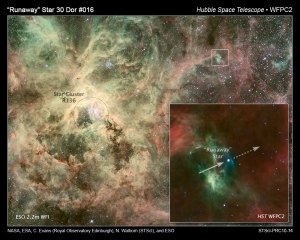
Traveling at 250,000 mph would be a windy, visually spectacular ride to hell
Space news (Astrophysics: stellar nursery dynamics; runaway stars) – 170,000 light-years from Earth, near the edge of the Tarantula Nebula –
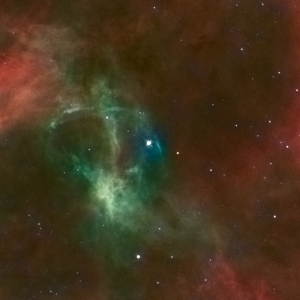
If you want to travel through the galaxy, hitch a ride on a runaway star like the one astronomers have been tracking since it came screaming out of 30 Doradus (Tarantula Nebula) in 2006. Data collected by the newly installed Cosmic Origins Spectrograph on the Hubble Space Telescope suggests a massive star, as much as 90 times the mass of Sol, was knocked out of the nebula by gravitational interactions with even more massive suns. Traveling at around 250,000 mph, voyaging through the cosmos on this runaway star would be an adventure to write home about.
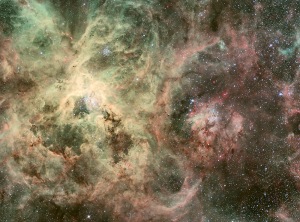
The trail leads back to a star-forming region deep within the Tarantula Nebula called R136, where over 2,400 massive stars near the center of this huge nebula produce an intense wind of radiation. Astronomers think interactions with some of the 100 plus solar mass stars detected in this stellar nursery resulted in this runaway star being flung over 375 light-years by its bigger siblings.
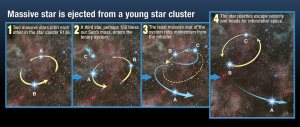
“These results are of great interest because such dynamical processes in very dense, massive clusters have been predicted theoretically for some time, but this is the first direct observation of the process in such a region,” says Nolan Walborn of the Space Telescope Science Institute in Baltimore and a member of the COS team that observed the misfit star. “Less massive runaway stars from the much smaller Orion Nebula Cluster were first found over half a century ago, but this is the first potential confirmation of more recent predictions applying to the most massive young clusters.”
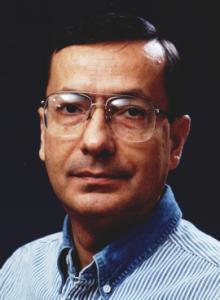
Astrophysicists studying the runaway star and the region in the Tarantula region where the trail ended believe it’s likely a massive, blue-white sun at least ten times hotter than Sol and only a few million years old. It’s far from home and in a region of space where no clusters with similar stars are found. It’s also left an egg-shaped cavity in its wake with glowing edges pointing in the direction of the center of 30 Doradus and the region of R136. A flaming trail you would see behind the star as you traveled across the cosmos and onto eternity.
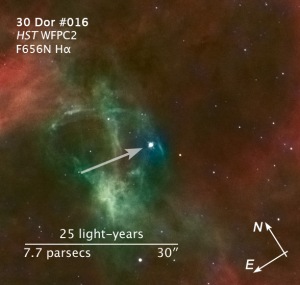
“It is generally accepted, however, that R136 is sufficiently young, 1 million to 2 million years old, that the cluster’s most massive stars have not yet exploded as supernovae,” says COS team member Danny Lennon of the Space Telescope Science Institute. “This implies that the star must have been ejected through dynamical interaction.”
This runway star continues to scream across the cosmos, nearing the outskirts of 30 Doradus a star-forming region in the Large Magellanic Cloud, it will one day end its existence in a titanic explosion or supernova, and possibly leave behind one of the most mysterious and enigmatic objects discovered during the human journey to the beginning of space and time, a black hole.
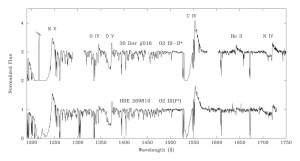
Imagine riding this runaway star until it contracted into a black hole and left our universe altogether. Where would we travel? To a random location in spacetime? To another reality or universe? The possibilities abound and far exceed our ability to imagine such a reality. Scientists tell us such a journey wouldn’t be possible, but they’re just stumbling around in the dark looking for ideas to grasp. For handholds on the dark cliff we climb as we search for answers to the mysteries before us.
What’s next?
Astronomers continue to study the Tarantula Nebula and the star-forming region R136 looking for signs of impending supernovae among the zoo of supermassive stars within. They also continue to track this runaway star and two other blue hot, supermassive stars outside the boundary of 30 Doradus that appear to have also been ejected from their host systems. We’ll update you with any news on it, and other runaway stars as it continues to scream across the cosmos.
You can follow the space journey of NASA here.
Experience the space voyage of the ESA.
Learn more about the Tarantula Nebula here.
Read about the discoveries of the Hubble Space Telescope.
Explore NASA’s Space Telescope Institute here.
Discover everything astronomers know about the star-forming region R136.
Discover the mysteries of the Large Magellanic Cloud here.
Read about the discoveries of the Chandra X-ray Observatory.
Read and learn more about ancient navigators “The Incredible Polynesian Navigators Followed the Stars“.
Learn what astronomers are discovering about the first black holes to exist in the universe.
Read about astronomers observe the shock wave of a supernova in visible light for the first time.

